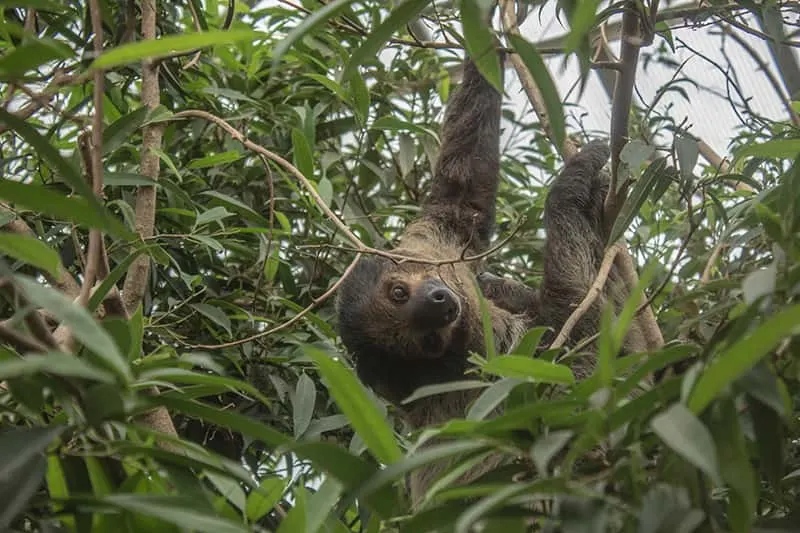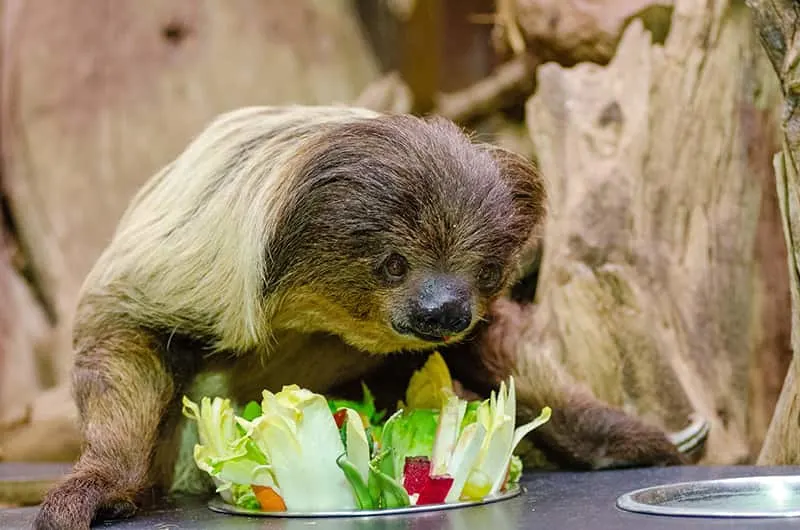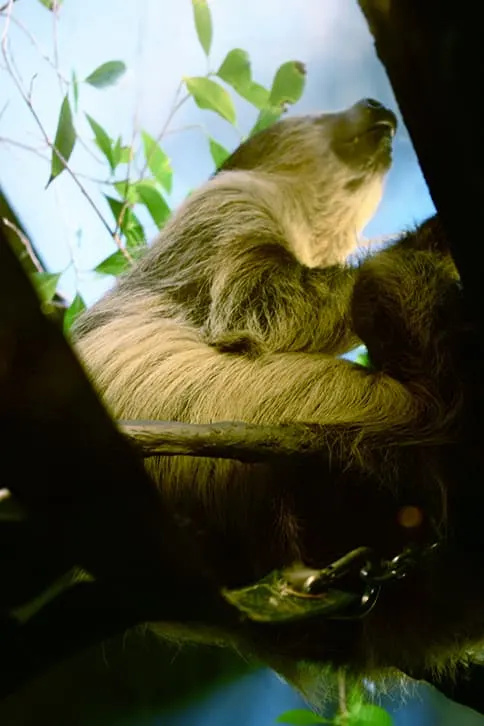Want to learn all about sloths? We’ll talk about their physical description, diet, offspring, and more! We will also share some fun sloth facts for kids.

There are six species of sloth that are split into two groups. Sloths are defined by how many claws they have on their front limbs. There are two species of two-toed sloth. There are four species of three-toed sloth.
The four species of three-toed sloths are:
- Pygmy three-toed sloth (Bradypus pygmaeus)
- Maned sloth (Bradypus torquatus)
- Pale-throated sloth (Bradypus tridactylus)
- Brown-throated sloth (Bradypus variegatus)
The two species of two-toed sloths are:
- Linnaeus’s two-toed sloth (Choloepus didactylus)
- Hoffman’s two-toed sloth (Choloepus hoffmanni)
We will be talking about both the two-toed and three-toed sloth groups.
Physical Description
The difference between two-toed and three-toed sloths is the number of claws on their front limbs. Two-toed sloths have two claws each, while three-toed sloths have three.
The appearance of the two-toed and three-toed sloths is similar. Both have flat heads, big sad-looking eyes, small ears, and short snouts. The sloths in both groups have a long trunk and four long limbs.
Each of the back limbs has three claws. Their limbs are curled all the time. The claws are actually finger bones. The hair on their faces is short. The three-toed sloth’s facial fur is colored as though it is smiling and wearing a black mask. The bodies of both sloths have long, shaggy fur.
Sloths range in size and weight. They are between two and two-and-a-half feet long and weigh between eight and seventeen pounds. Two-toed sloths are a bit bigger than their three-toed counterparts. The two-toed sloth has no tail, but the three-toed sloth has a two-and-a-half-inch tail.
Sloth Fur
The two-toed sloth has golden brown fur. The three-toed sloth has gray-brown fur. The three-toed sloth is usually darker in color than the two-toed sloth. All sloths have two layers of fur. Their soft undercoat helps them stay warm. The coarse outer layer of fur serves as camouflage.
Sloth fur has its own little ecosystem. A sloth's fur often has insects living in it and algae growing on it. The moth and beetle species that live in a sloth's fur can’t be found anywhere else. Other insects, such as mites and ticks, often live in a sloth’s fur.
The algae found in a sloth’s fur is unique. The algae is part of a sloth's camouflage. Sloths nibble on the algae for extra nutrients. The algae and sloth help each other. This is known as a symbiotic relationship.

Habitat
All sloths live in rainforests. Sloths live in an area of about ten acres of rain forest canopy. Sloths are found in Central America and northern South America.
Habits
Sloths spend most of their time alone. A sloth lives near the top of a tree, grooming, eating, and napping. Two-toed sloths are usually active at night. Three-toed sloths are active during the day and night.
Sloths nap for about eight to ten hours every day. They have a very slow metabolism. A sloth needs to conserve its energy because its diet doesn't provide much fuel.
A sloth’s curled limbs help it latch onto tree branches. They also have special muscles that allow them to hang from trees without using any energy.
Sloths come down from their trees to poop. They poop in the same spot once a week. They cover their poop with leaves. Sloths save energy by not climbing up and down the tree all the time.
Sloths don't control their body temperatures like other mammals. They control their body temperatures the same way cold-blooded animals do. Sloths will look for warm and cool areas to help regulate their body temperature.
Diet

Sloths are omnivores. Three-toed sloths eat mostly plants. Two-toed sloths have a mixed diet. Sloths can eat fruit, lizards, and insects, among other things. Both enjoy eating fresh leaves from the cecropia family of trees.
Sloths need to eat one and a half pounds of leaves each day. Sloths get water from the leaves they eat or by drinking from a nearby river.
Offspring
Sloths typically breed after a rainy season because that’s when the most food is available. However, they can breed at any time of the year.
Two-toed sloths attract mates differently than three-toed sloths do. Two-toed sloths leave their scent on trees to attract a mate. Female three-toed sloths have a mating call that they use to attract males. Male sloths fight over females by trying to knock each other down from a tree. Female sloths mate with more than one male.
Female sloths give birth once every two years on average. Mother sloths can be pregnant for up to a year. When she is ready to give birth, the mother moves down to a lower branch. This way, the baby will not get hurt if it falls. Mother sloths give birth while hanging upside down.
Sloths have open eyes, sharp claws, and teeth when they are born. They weigh between ten and seventeen ounces. Two-toed sloth cubs are heavier than three-toed sloth cubs at birth.
Sloth cubs drink their mom’s milk. They also learn what food to eat by licking their mom’s lips. Babies cling to their mothers’ chests until they are old enough to practice climbing on their own. When the sloth cub is old enough, the mother moves to a new area.
Classification/Taxonomy
Kingdom: Animalia
Phylum: Chordata
Class: Mammalia
Order: Pilosa
Family: Bradypodidae (3-toed), Megalonychidae (2-toed)
Genus: Bradypus (3-toed), Choloepus (2-toed)
History
Two and three-fingered sloths look and act similar, but they are not closely related. Giant ground sloths are thought to be the ancestors of today's sloths. However, the two-toed and three-toed sloths each evolved independently. They evolved in a similar way as they each adapted to their own habitat.
Predators
Sloths are simple prey to catch since they move slowly. Sloths are hunted for food by jaguars, eagles, and humans. Other issues provide a greater threat to sloths than predators. Trees are being cut down in their rainforest habitat. Sloth habitats are also being fragmented into smaller parts that aren't connected. Finally, humans are expanding into areas where sloths live. Sloths are affected by construction and transportation, among other things.

Lifespan
We believe that sloths can live up to thirty years in the wild. However, we really don't know how long they live. Two-toed sloths can live up to fifty years in captivity. Three-toed sloths die quickly in captivity.
25+ Unusual Sloth Facts for Kids
- Each sloth species has its own ecosystem and is unable to adapt to other environments.
- Sloths do not make good pets.
- Three-toed sloths have slightly longer tails than two-toed sloths.
- Three-toed sloths can turn their heads 270 degrees.
- A two-toed sloth’s head can only turn 90 degrees.
- Two-toed sloths hang upside-down from tree branches more often than three-toed sloths.
- Sloths are good swimmers and can swim three times faster than they can travel on land.
- Sloths swim by floating and steering with their arms.
- Three-fingered sloths bury their poop in a hole dug by their tail.
- Sloths have seven to twelve favorite trees that they eat from.
- Sloths can hold their breath for forty minutes underwater.
- Two-toed sloths eat soil and stones to help their digestion.
- A sloth has the lowest metabolic rate of any land mammal that doesn't hibernate.
- Sloths are colorblind.
- Sloths have a great sense of smell.
- Sloths are three times stronger than humans.
- Sloths groom their fur every day.
- Birds eat insects from the fur of sloths.
- More algae will grow on a sloth’s fur if it has more moths in its fur.
- Sloths are also known as “two-and-three-fingered sloths” because they lack toes.
- When people first saw sloths, they thought sloths were lazy and useless.
- “Sloth” comes from an old English word that means “lazy.”
- Sloths can survive a 90-foot fall because their 46 ribs give them extra flexibility.
- Two-toed sloths are more active and a bit faster than three-toed sloths.
- A sloth travels the distance of half a football field in a day.
- Sloths can't walk. They must drag themselves across the ground with their claws.
- A sloth loses 1/3 of its body weight when it poops.
- Most predators are unaware of sloths because they move slowly.
- A mother sloth can swim with a baby on her back.
- Sloth teeth turn black because they don't have an enamel layer.
- People discovered a three-toed sloth mama who adopted a two-toed sloth baby.
- A group of sloths is called a “snuggle.”
- If a sloth cub falls from a tree, it will cry out until the mom reaches it.
- Three-toed sloths raise their cubs for 6 months, while two-toed sloths spend twice as long.
- Sometimes sloths will swim in a river to cool down or move to new territory.
- There are about 50 Pygmy three-toed sloths left in the world.
We hope you enjoyed learning all about sloths! Did you discover anything new? Please share any other facts you know. We'd love to hear from you!
Want to read about other mammals? Check out these posts!
